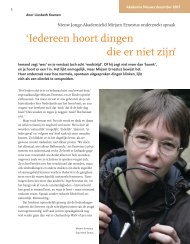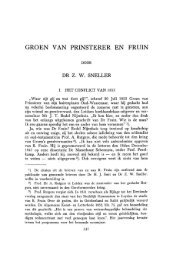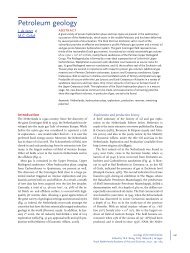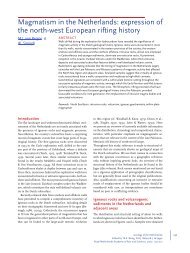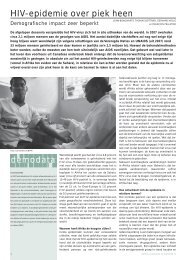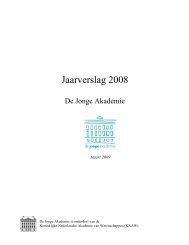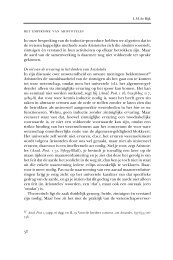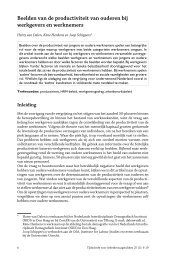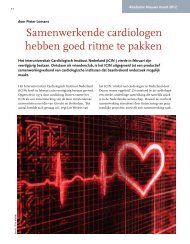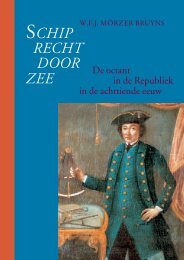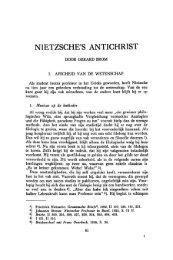The case of Clusius' Exoticorum libri decem - KNAW
The case of Clusius' Exoticorum libri decem - KNAW
The case of Clusius' Exoticorum libri decem - KNAW
Create successful ePaper yourself
Turn your PDF publications into a flip-book with our unique Google optimized e-Paper software.
Uses <strong>of</strong> pictures in printed books:<br />
<strong>The</strong> <strong>case</strong> <strong>of</strong> Clusius’ <strong>Exoticorum</strong> <strong>libri</strong> <strong>decem</strong><br />
Sachiko Kusukawa<br />
As Ivins noted many years ago, exactly replicable pictures became a viable<br />
means <strong>of</strong> communicating visual information for the fi rst time after the advent<br />
<strong>of</strong> the movable-type press. 1 It does not follow straightforwardly, however, that<br />
the increasing use <strong>of</strong> pictures, say, in printed books about the materia medica<br />
in the early modern period proves a dramatic change in the visual practice <strong>of</strong><br />
science. 2 Printers, for instance, played a signifi cant role in determining the<br />
presence, quality and quantity <strong>of</strong> pictorial matter in a printed book. Carolus<br />
Clusius wrote and published in a world where printed books and their pictures<br />
had their advantages as well as limitations as conveyers <strong>of</strong> knowledge. My aim<br />
in this chapter is to discuss an attempt that he made, in the <strong>Exoticorum</strong> <strong>libri</strong> <strong>decem</strong>,<br />
to use pictures effectively in order to create knowledge about the nature<br />
<strong>of</strong> the exotic that was credible and ‘legitimate’. In order to appreciate what we<br />
may or may not be able to infer from the pictures in printed illustrated books,<br />
however, I shall fi rst discuss the world <strong>of</strong> printed books in which Clusius lived<br />
as an author.<br />
<strong>The</strong> world <strong>of</strong> printers, books and woodcuts3 In 1542, Michael Isengrin at Basel published Leonhard Fuchs’ De historia<br />
stirpium commentarii insignes, with 511 fi gures with no repeats. <strong>The</strong> fi gures were<br />
mostly <strong>of</strong> folio size, had minimum shading, were intended to be coloured, and<br />
I would like to thank Florike Egmond, Robert Visser, Paul H<strong>of</strong>tijzer and Kasper van Ommen for<br />
their hospitality at the Scaliger Institute in September 2004, where an early version <strong>of</strong> this paper was<br />
delivered; I am especially indebted to Florike Egmond for sharing her research material with me.<br />
1 W.M. Ivins Jr, Prints and visual communications (London, 1953).<br />
2 A more fruitful way to look at this topic is in terms <strong>of</strong> the relationship between text and image, as<br />
exemplifi ed in B.W. Ogilvie, ‘Image and text in natural history, 1500-1700’, in Wolfgang Lefèvre,<br />
Jürgen Renn and Urs Schoepfl in (eds.), <strong>The</strong> power <strong>of</strong> images in early modern science (Basle/Boston/Berlin,<br />
2003), 141-166.<br />
3 As will be clear from my notes, for this section, I am greatly indebted to the scholarship by Leon<br />
Voet, Francine de Nave and Dirk Imh<strong>of</strong>.<br />
carolus clusius<br />
royal netherlands academy <strong>of</strong> arts and sciences, 2007 221
functioned as an ‘Idealbild’, to represent an object as universal as possible. 4<br />
<strong>The</strong>se woodcuts were used again, with additional cuts, in the following year in<br />
Fuchs’ New Kreüterbuch. This German edition was not an exact translation <strong>of</strong><br />
the Latin edition which sought to recover the pristine knowledge <strong>of</strong> medicinal<br />
herbs. Instead, it abridged some <strong>of</strong> the Latin arguments, and with the new<br />
index <strong>of</strong> diseases that could be treated by the plants described, it became more<br />
a reference manual for medical treatment. Some copies <strong>of</strong> these folio editions<br />
appear to have been sold coloured. 5 In 1545, Isengrin had these pictures<br />
copied and re-cut to a smaller size (octavo), printing two pictorial editions, one<br />
in German and another in Latin, with minimum text. Fuchs described them as<br />
being made for the students <strong>of</strong> plants (‘studosis herbariae rei’) to take with<br />
them on trips or walks into the country and compare them with plants found<br />
in the country. 6 Although in modern bibliographic terms, the German and the<br />
pictorial versions might be described as editions <strong>of</strong> Fuchs’ De historia stirpium,<br />
these editions address slightly different (though not necessarily mutually exclusive)<br />
audiences, and thus different sectors <strong>of</strong> the book-buying market. In this<br />
way, the same, exactly repeatable pictures could be part <strong>of</strong> a printer’s strategy<br />
<strong>of</strong> diversifying his product in order to maximise its market appeal.<br />
In 1552, the Antwerp printer Jan van der Loe procured a privilege to revise<br />
and augment Fuchs’ New Kreüterbuch, for which he solicited the help <strong>of</strong> Rembert<br />
Dodoens (Dodonaeus). 7 Van der Loe spread the cost <strong>of</strong> the project by<br />
publishing illustrated herbals in a smaller format (octavo), and in stages: De<br />
frugum historia liber unus (1552); Trium priorum de stirpium historia (1553); Trium<br />
4 For the universalising tendency <strong>of</strong> Fuchs’ fi gures, see S. Kusukawa, ‘<strong>The</strong> uses <strong>of</strong> pictures in the<br />
formation <strong>of</strong> learned knowledge: <strong>The</strong> <strong>case</strong>s <strong>of</strong> Leonhard Fuchs and Andreas Vesalius’, in eadem<br />
and I. Maclean (eds.), Transmitting knowledge: Words, images, and instruments in early modern Europe<br />
(Oxford, 2006), 73-96. <strong>The</strong> reasons for Fuchs’ insistence on a one-to-one match between text and<br />
image is discussed in S. Kusukawa, ‘Leonhart Fuchs on the importance <strong>of</strong> pictures’, Journal <strong>of</strong> the<br />
history <strong>of</strong> ideas, 58/3 (1997), 403-427.<br />
5 A. Arber, ‘<strong>The</strong> colouring <strong>of</strong> sixteenth-century herbals’, in her Herbals: <strong>The</strong>ir origin and evolution:<br />
A chapter in the history <strong>of</strong> botany 1470-1670, ed. W.T. Stearn (Cambridge, 1990), 315-318. For the problems<br />
<strong>of</strong> identifying current copies that were coloured originally, see F.G. Meyer, with E.E. Trueblood,<br />
and J.L. Heller (eds.), <strong>The</strong> great herbal <strong>of</strong> Leonhart Fuchs: De historia stirpium commentarii<br />
insignes, 1542, 2 vols. (Stanford, 1999), vol. I, 119f.<br />
6 ‘Caeterum cum eius operas propter suam molem ac magnitudinem, non nisi domi usus esse possit,<br />
de ratione aliqua mihi cogitandum fuit, qua effi cerem ut herbariae rei studiosis ita consulerem, ut<br />
peregrinantem etiam ac deambulantes haberent, quibus cum nativas herbas rure inventas conferrent.<br />
Neque enim ulla via ad recte cognoscendas stirpes expeditior, quam illa nativarum ad pictures diligens<br />
collatio.’ L. Fuchs, Primi de stirpium historia commentariorum tomi vivae imagines, in exiguam angustioremque<br />
formam contractae (Basle, 1545), A2r.<br />
7 <strong>The</strong> imperial privilege is dated 27 May, 1551, R. Dodoens, De frugum historia (Antwerp, 1552), A1v.<br />
222 sachiko kusukawa
posteriorum de stirpium historia (1554). 8 <strong>The</strong> complete Dutch version <strong>of</strong> Fuchs’<br />
New Kreüterbuch by Dodoens, the Cruijdt-boeck, was then printed in 1554 in<br />
folio, containing 710 illustrations (500 cuts copied from Fuchs, and 210 newly<br />
cut). Van der Loe proceeded to print a French edition, translated by Clusius, in<br />
1557, with an additional 108 woodblocks. 9 Like Isengrin, Van der Loe then<br />
produced a pictorial, octavo version in two volumes in 1559. By the year <strong>of</strong><br />
Van der Loe’s death (1563), when a revised edition was printed, the Cruijdtboeck<br />
had 861 woodcuts.<br />
Plantin emulated van der Loe in the way he published works on plants: by<br />
printing in stages to increase gradually the stock <strong>of</strong> woodcuts, and by maximising<br />
the use <strong>of</strong> the woodcuts in diverse publications. In 1566, he fi rst printed<br />
Dodoens’ Frumentorum, leguminum, palustrium et aquatilium herbarum […] historia,<br />
which was a revised edition <strong>of</strong> his De frugum historia (1552), and would eventually<br />
become part <strong>of</strong> the Stirpium historiae pemptades sex (1583). <strong>The</strong> Frumentorum<br />
[…] historia contained 280 octavo pages with 81 illustrations. 10 800 copies were<br />
printed, for which paper cost 35 fl . 12 st., and the setting, printing, and compiling<br />
<strong>of</strong> an index cost 27 fl ., a total <strong>of</strong> 62 fl . 12 st. 11 Although Plantin did not<br />
include the cost <strong>of</strong> the illustrations when setting the price <strong>of</strong> this book, we do<br />
know that Peeter vander Borcht was paid 5 patavars per drawing copied from<br />
Van der Loe’s Cruijdt-boeck. 12 <strong>The</strong> drawings, in turn, were cut by Cornelius<br />
Muller, Gerard Janssen van Kampen or Arnold Nicolai, who were paid 8 stuivers<br />
for each wood block. 13 Thus the cost for illustrations would have come<br />
around to 54 fl ., just under 50% <strong>of</strong> the total cost <strong>of</strong> printing. 14 This amount <strong>of</strong><br />
outlay itself was negligible within the context <strong>of</strong> Plantin’s annual running cost<br />
<strong>of</strong> 13,041 fl . for that year, 15 but it is still signifi cant that newly cut woodcuts<br />
8 F. de Nave and D. Imh<strong>of</strong> (eds.), Botany in the Low Countries (end <strong>of</strong> the 15th century – ca. 1650) (Antwerp,<br />
1993) [Exhibition catalogue, Plantin-Moretus Museum, Antwerp], 98-100.<br />
9 Ibid., 101.<br />
10 I.e. 78 woodblocks with repeats, C. Depauw, ‘Peeter vander Borcht (1535/40-1608): <strong>The</strong> artist as<br />
inventor or creator <strong>of</strong> botanical illustrations?’, in De Nave and Imh<strong>of</strong> (eds.), Botany in the Low<br />
Countries, 49.<br />
11 L. Voet, ‘Christopher Plantin as a promoter <strong>of</strong> the science <strong>of</strong> botany’, in De Nave and Imh<strong>of</strong><br />
(eds), Botany in the Low Countries, 44.<br />
12 De Nave and Imh<strong>of</strong> (eds.), Botany in the Low Countries, 103. Cf. Dodoens’ claim: ‘De ijs [imaginibus]<br />
autem, quae huic historiae additae sunt, affi rmare possumus, eas ex vivarum herbarum imitatione<br />
depictas.’ R. Dodoens, Frumentorum, leguminum, palustrium et aquatilium herbarum […] historia<br />
(Antwerp, 1566), 19. My interpolation. See also Depauw, ‘Peeter vander Borcht’, 49f.<br />
13 In his accounting, Plantin used the Carolus guilder (abbreviated as ‘fl .’), divided into 20 stuivers<br />
or patavars (abbreviated as ‘st.’); L. Voet, <strong>The</strong> Golden Compasses: A history and evaluation <strong>of</strong> the printing<br />
and publishing activities <strong>of</strong> the Offi ciana Plantiniana at Antwerp, 2 vols. (Amsterdam/London, 1969-72),<br />
vol. I, 440.<br />
14 Voet, ‘Plantin as a promoter’, 44.<br />
15 Voet, <strong>The</strong> Golden Compasses, vol. II, 227.<br />
uses <strong>of</strong> pictures in printed books 223
cost more than the paper, which was normally the largest cost involved in<br />
printing. Plantin would then spend 82 guilders for another new set <strong>of</strong> 108<br />
woodblocks, for Dodoens’ Florum et Coronarum odoratorumque […] historia, printed<br />
in 1568 (and used again in the Stirpium historiae pemptades sex). 16 In 1574,<br />
Dodoens’ Purgantium aliarumque […] historia <strong>libri</strong> III, containing 221 illustrations<br />
was published. 17 In 1578 Plantin lent 37 blocks from Dodoens’ works to<br />
Hendrik van der Loe, who used them, together with woodblocks from his father’s<br />
(Jan van der Loe) stock, to print an English translation (by Henry Lyte)<br />
<strong>of</strong> Dodoens’ Cruijdt-boeck. 18<br />
It is as if there was a division <strong>of</strong> labour between Dodoens and Clusius for<br />
the Plantin press, since Clusius fi rst published with Plantin on medicinal plants<br />
not commonly found in the comprehensive herbals <strong>of</strong> Fuchs and Dodoens. 19<br />
Clusius, in turn, believed that the study <strong>of</strong> plants was so immense that nobody<br />
so far had managed to publish a ‘complete (absoluta) historia’, though some<br />
had brought to light plants hitherto unknown. 20 Clusius persuaded Plantin to<br />
publish books on New-World fl ora and fauna which had largely been issued in<br />
the vernacular. He helped Plantin expand the market for these books by translating<br />
into Latin the vernacular works on the subject already published, thus<br />
turning Garcia ab Orta’s Coloquios dos simples (Goa, 1563) into the Aromatum et<br />
simplicium aliquot medicamentorum apud Indos nascentium historia (Antwerp, 1567);<br />
Nicolas Monardes’ De las drogas de las Indias (Seville, 1565 and 1571) into the<br />
De simplicibus medicamentis ex Occidentali India delatis quorum in medicina usus est<br />
(Antwerp, 1574); Christophorus a Costa’s Tradado de las drogas medicinas y plantas<br />
de las Indias Orientales (Burgos, 1578) into the Aromatum et medicamentorum in<br />
Orientali India nascentium liber (Antwerp, 1582). Each title underwent revisions<br />
and all were published together in 1593. It is important to note the traditional,<br />
medicinal orientation <strong>of</strong> these publications. For instance, in De simplicibus medicamentis<br />
Clusius described the ‘Lapis tiburonum’, stones found in the head <strong>of</strong><br />
sharks (‘tiburones’), which had been described by Monardes as white, large,<br />
heavy, and when ground into a powder, very effective for ‘nephriticis’, urinary<br />
16 Voet, ‘Plantin as a promoter’, 41; De Nave and Imh<strong>of</strong> (eds.), Botany in the Low Countries, 105.<br />
17 L. Voet, <strong>The</strong> Plantin press (1555-1589): A bibliography <strong>of</strong> the works printed and published by Christopher<br />
Plantin at Antwerp and Leiden, 6 vols. (Amsterdam, 1980-83), no. 1099.<br />
18 De Nave and Imh<strong>of</strong> (eds.), Botany in the Low Countries, 105.<br />
19 Cf. Fuchs’ new world plants, see Meyer, <strong>The</strong> great herbal, vol. I, 133. For the tobacco plant in Dodoens’<br />
work, see De Nave and Imh<strong>of</strong> (eds.), Botany in the Low Countries, 110f.<br />
20 ‘Rei vero herbariae studium adeo immensum est, ut absolutam plantarum historiam nemo hactenus<br />
evulgarit, sed aliqui duntaxat ignotas nobis plantas interdum in lucem pr<strong>of</strong>erunt.’ N. Monardes,<br />
De simplicibus medicamentis ex occidentali India delatis, quorum in medicina usus est, tr. C. Clusius (Antwerp,<br />
1574), A2r.<br />
224 sachiko kusukawa
diffi culties and stones in kidneys. 21 As was <strong>of</strong>ten the <strong>case</strong>, Clusius then provided<br />
a note and quoted a description from Francisco López de Gómara’s<br />
Historia general de las Indias (1551) which suggested that a fi sh known by the<br />
name <strong>of</strong> ‘manatus’ had much in common with the ‘tiburones’. 22<br />
It is also worth nothing the modest outlay for the illustrations in these<br />
works. Ab Orta’s Aromatum et simplicium aliquot medicamentorum apud Indos nascentium<br />
historia (1567) contained 264 octavo pages and 16 illustrations (drawn by<br />
Vander Borcht and cut by Nicolai), and was issued in 1250 copies, for which<br />
the total cost <strong>of</strong> printing was 91 fl . 2 st., including 47 fl . 6 st. for paper and 10<br />
fl . 10 st. for illustrations; thus the woodcuts cost just over 10% <strong>of</strong> the total<br />
cost, but the paper over 50%. 23 Plantin gradually increased the number <strong>of</strong> illustrations<br />
(and the sales price) in successive editions, but the increases were<br />
modest: the second edition in 1574 contained 27 illustrations and the third edition<br />
<strong>of</strong> 1579 had 28 illustrations. 24 This was similarly the <strong>case</strong> with the work <strong>of</strong><br />
Monardes: De simplicibus medicamentis ex Occidentali India delatis (1574) contained<br />
10 illustrations and the second edition in 1579 had just three more. 25 Clusius<br />
was critical <strong>of</strong> the pictures in A Costa’s original edition, and the fi rst edition <strong>of</strong><br />
the Aromatum et medicamentorum […] liber (1582) contained only two illustrations,<br />
only one <strong>of</strong> which had been copied from the original edition. 26 This<br />
single picture, in fact, was included in order to show how false and unreliable<br />
A Costa’s description <strong>of</strong> the ‘Caryophyllus’ was. Clusius referred the reader<br />
instead to the proper (‘legitima’) picture <strong>of</strong> the clove tree in Ab Orta’s Aromatum<br />
et simplicium aliquot medicamentorum apud Indos nascentium historia (1567). 27 <strong>The</strong><br />
21 Ibid. 52.<br />
22 Ibid. 52f. Cf. F. López de Gómara, Historia general de las Indias, ed. P. Guibelalde and E.M. Aguilera,<br />
2 vols. (Barcelona, 1954), vol. I, 54f.<br />
23 Voet, <strong>The</strong> Plantin press, no. 1838.<br />
24 Voet, <strong>The</strong> Plantin press, nos. 1839-1840. <strong>The</strong> Aromatum et simplicium […] historia, fi rst edition (1567)<br />
was sold for 4 st., the second edition (1574), 4 1 ⁄ 2 st., and the third edition (1579) 6 st.; we only know<br />
the price for the fi rst edition <strong>of</strong> Monardes’ De simplicibus medicamentis […] (1574): 1 1 ⁄ 2 st; and <strong>of</strong> the<br />
fi rst edition <strong>of</strong> A Costa’s Aromatum et medicamentorum […] liber (1582) at 1 st. Voet, ‘Plantin as a promoter’,<br />
42.<br />
25 Voet, <strong>The</strong> Plantin press, nos. 1710-1712.<br />
26 ‘Icones praeterea, quas ad vivum expressisse passim gloriatus, suis locis insperserat, reieci, quoniam<br />
plane ineptae essent, et nihil minus, quam legitimas stirpes referrent: uti ex unica Caryphyllorum<br />
arborum effi gie (quam idcirco intuli, ut cum legitima, Garciae adiecta, conferre liceat) quilibet<br />
iudicare poterit.’ C. A Costa, Aromatum et medicamentorum in Orientali India nascentium liber, tr. C. Clusius<br />
(Antwerp, 1582), 5. <strong>The</strong> other picture is that <strong>of</strong> a fragment <strong>of</strong> the ‘Lignum Colubrinum’ given to<br />
Clusius by Hector Nunez, ibid., 52f.<br />
27 ‘[…] ipsius verba, lectori proponenda censui, ut animadvertere queat quam parum fi dei interdum<br />
huic auctori sit adhibendum, qui veritatis assertorem se gloriatur, et plantas ad vivum expressisse<br />
asserit, cum tamen ipsius icones nullius stirpis vivam effi giem imitentur, praesertim earum quas<br />
hactenus nobis videre licuit. Caryophyllorum certe legitimam iconem in Aromatum Garciae historia<br />
uses <strong>of</strong> pictures in printed books 225
second edition <strong>of</strong> A Costa’s Aromatum […] (1593) retained only the fi gure <strong>of</strong><br />
the ‘Caryophyllus’ from the 1582 edition, rather than replacing it with another<br />
picture. For Clusius, a false picture could be used to distinguish between true<br />
and false descriptions by different authors. <strong>The</strong> modest uses <strong>of</strong> pictures in<br />
Clusius’ translations in general suggest that Plantin’s strategy for publishing<br />
this genre <strong>of</strong> exotic medicine remained rather conservative, building on existing<br />
publications (in the vernacular), turning them into Latin to expand into an<br />
international market on rare and exotic medicines, but limiting the fi nancial<br />
risk by creating only a small amount <strong>of</strong> woodcuts and keeping the cost per title<br />
down.<br />
This may partly explain why Clusius’ own work on the rare and the exotic<br />
suffered somewhat at the hands <strong>of</strong> Plantin. Clusius had collected plants on a<br />
trip in 1566 to Spain and Portugal, accompanying Jacob Fugger. 28 In the summer<br />
<strong>of</strong> 1568, he carefully supervised Peeter vander Borcht to draw pictures <strong>of</strong><br />
plants from dried specimens. 29 <strong>The</strong> pictures were ready by 1569, but Plantin<br />
used them fi rst for Dodoens’ Purgantium […] herbarum historiae <strong>libri</strong> IIII (1574). 30<br />
Clusius’ own work was published in 1576 (the privilege is dated 1575), as the<br />
Rariorum aliquot stirpium per Hispanias observationum historia, with 544 octavo pages<br />
and 233 fi gures, which in turn included woodcuts from Dodoens’ Purgantium<br />
[…] herbarum historia. Despite his claim <strong>of</strong> including the rare and the unknown<br />
varieties, Clusius conceded that some would notice that the pictures had appeared<br />
in other books before. He explained, however, that he had let Dodoens<br />
freely use his pictures for the Purgantium […] herbarum historia, because the<br />
bonds <strong>of</strong> true friendship (‘vincula amicitiae verae’) are such that possessions<br />
should be freely shared rather than printed as one’s own. 31 Such a friendship in<br />
exhibui, […]’ A Costa, Aromatum […] (1582), 33. Voet, ‘Plantin as a promoter’, 52f. De Nave and<br />
Imh<strong>of</strong> (eds.), Botany in the Low Countries, 117. Garcia ab Orta, Aromatum et simplicium aliquot medicamentorum<br />
apud Indos nascentium historia (Antwerp, 1567), 102 for the picture <strong>of</strong> the ‘Garyophillus’.<br />
28 ‘In ista peregrinatione plurimarum formam, natales, et nomina memoriae causa adscripsi, nonnullarum<br />
etiam effi gies ipse carbone aut rubria delineavi, atque omnes fere inde rediens exsiccates<br />
detuli; aut earum semina, vel ipsas etiam plantas, quae videlicet vecturae tradidatem ferre potuerunt<br />
(quales sunt bulbosae et tuberosae) amicis inde misi.’ C. Clusius, Rariorum aliquot stirpium per Hispanias<br />
(Antwerp, 1576), 7.<br />
29 ‘Eaque adeo de causa, biennio post, industrium et diligentem pictorem nactus, stirpium icones in<br />
tabellis ligneis depingendas curavi, et plerunque etiam ipsi pictori adstiti, ut de his quae in siccarum<br />
plantarum forma exprimenda diligentius erant observanda, commonefacerem.’ Clusius, Rariorum<br />
aliquot stirpium per Hispanias, 8.<br />
30 Voet, <strong>The</strong> Plantin press, no. 1099; Dodoens’ work included 33 woodcuts from Clusius’ Spanish<br />
fl ora, and Clusius borrowed 6 from Dodoens’ work, making the overlap between the two works 39<br />
woodcuts.<br />
31 ‘…nec etiam cuiquam novum videatur, si plerasque stirpium effi gies in hoc libello conspexerit,<br />
quas apud alios, qui suas lucubrationes ante me ediderunt, viderit. Ea enim sunt verae amicitiae<br />
vincula, ut illam nihil peculiare, nihil sibi proprium habere putem: sed quaecunque habent amici,<br />
226 sachiko kusukawa
sharing pictures was made possible because both Clusius and Dodoens were<br />
publishing with the same printer, Plantin; from the point <strong>of</strong> the printer, such a<br />
sharing <strong>of</strong> woodcuts was fi nancially necessary. This is in marked contrast to<br />
the way Fuchs, for instance, felt proprietary about his own woodblocks. 32<br />
In 1576, Plantin printed a ‘hybrid’ work by Matthias Lobelius, the Plantarum<br />
seu stirpium historia (1576), 33 with 782 woodblocks cut anew at the cost <strong>of</strong> 523 fl . 34<br />
Of the total 1790 illustrations contained in this work, over 700 were those<br />
previously used in the works <strong>of</strong> Dodoens and <strong>of</strong> Clusius. As the second part<br />
<strong>of</strong> this work, Plantin tacked on Lobelius’ Stirpium adversaria nova, composed<br />
with Pierre Pena and published in London by Thomas Purfoot in 1571. Plantin<br />
had bought 800 copies <strong>of</strong> Purfoot’s edition <strong>of</strong> Stirpium adversaria nova for<br />
1,200 fl ., and around 250 <strong>of</strong> the woodblocks (the bulk <strong>of</strong> which arrived in<br />
Antwerp in 1580), at the extra expense <strong>of</strong> 120 fl . 35 <strong>The</strong> Plantarum seu stirpium<br />
historia dealt with the materia medica, especially <strong>of</strong> Dioscorides; in it Lobelius<br />
defended the knowledge <strong>of</strong> the ancients against claims <strong>of</strong> ‘new medicines’<br />
promoted by the works <strong>of</strong> Paracelsus and his followers, 36 and he included a list<br />
<strong>of</strong> formulas for medicines by Guillaume Rondelet. 37<br />
In addition to the Purfoot woodblocks, Plantin acquired some 1000 <strong>of</strong> the<br />
plant woodcuts from Jan van der Loe’s widow in 1581. 38 <strong>The</strong>se were put to<br />
good use in the same year, in Lobelius’ Flemish edition <strong>of</strong> the Plantarum seu<br />
stirpium historia, the Cruijdt-boeck, containing 1408 folio pages with 2187 illustrations,<br />
and sold for 6 fl . 10 st a copy. 39 In the same year, at the behest <strong>of</strong><br />
Severinus Gobelius, physician to the Elector <strong>of</strong> Brandenburg, Plantin also<br />
issued a pictorial album, the Plantarum seu stirpium icones, in a horizontal quarto<br />
liberaliter inter se communicare debere. Inde factum est, ut clarissimus vir Rembertus Dodonaues,<br />
nunc Caesareus medicus, veteri amicitia mihi conjunctus, quas ex meis iconibus voluerit, libere in<br />
suam Purgantium historiam intulerit.’ Clusius, Rariorum aliquot stirpium per Hispanias, 9f.<br />
32 Kusukawa, ‘Fuchs on the importance <strong>of</strong> pictures’; see also Fuchs’ rejection <strong>of</strong> Conrad Gessner’s<br />
request to borrow the woodcuts <strong>of</strong> the De historia stirpium, J.L. Heller and F.G. Meyer, ‘Conrad Gessner<br />
to Leonhart Fuchs, October 18, 1556’, Huntia, 5/1 (1983), 67, 69, 75.<br />
33 ‘Hybrid’ is Voet’s expression in his ‘Plantin as a promoter’, 42.<br />
34 Voet, <strong>The</strong> Plantin press, no. 1578.<br />
35 ‘1580. Adi 4 e de may ils ont livré les fi gures de Londres dont sont d’accord avec C. Plantin qu’ils<br />
auront 20 livres, val. fl . 120’, Bibliotheca Belgica: Bibliographie générale des Pays-Bas, ed. F. van der Haeghen,<br />
re-ed. M.-T. Lenger, 6 vols. (Brussels, 1979), vol. III, 1129-1130.<br />
36 ‘Sunt enim recentiorum complures qui pr<strong>of</strong>i tentur, summeque gloriantur nova se invenisse remedia,<br />
novasque praeparandorum medicamentorum formulas, e quorum numero tenebricosis suis<br />
scriptis est Paracelsus; eiusque asseclae, cum tamen in Dioscoridis, aliisque veterum auctorum monumentis,<br />
huiuscemodi extrahendarum facultatum herbarum, praeparandorumque medicamentorum<br />
rartionem posteris traditam legamus.’ Lobelius, Plantarum seu stirpium historia (Antwerp, 1576), 4.<br />
37 Formulae aliquot remediorum Guillielmi Rondelletii […].<br />
38 Voet ‘Plantin as a promoter’, 41.<br />
39 Voet, <strong>The</strong> Plantin press, no. 1579.<br />
uses <strong>of</strong> pictures in printed books 227
format, with 1140 pages and 2176 illustrations; Gobelius bought 150 copies at<br />
36 st. each. 40 This pictorial album had minimal text – just the plant-names and<br />
references to Lobelius’ Plantarum seu stirpium historia and Cruydt-boeck. <strong>The</strong> index<br />
<strong>of</strong> plant names in Dutch, French, German, Italian, Spanish and English,<br />
made the album saleable across Europe. Gobelius also asked for a coloured<br />
copy <strong>of</strong> the Icones, to which Plantin replied that he did not have a coloured<br />
copy, and that furthermore, it would take at least three months, as it would be<br />
a laborious task. Instead, Plantin <strong>of</strong>fered him one <strong>of</strong> the three coloured copies<br />
<strong>of</strong> Lobelius’ Cruijdt-boeck that he had ready, and this is what Gobelius purchased.<br />
Plantin charged Gobelius one stuiver each for colouring 2,100 illustrations<br />
and hence this coloured herbal cost an extra 105 fl . on top <strong>of</strong> the 8 fl .<br />
for the book itself. 41 This kind <strong>of</strong> charge was exceptional, but it does suggest<br />
that Plantin had some ready-coloured copies <strong>of</strong> the Cruijdt-boeck. Nevertheless,<br />
it does not appear to have been a regular practice for Plantin to <strong>of</strong>fer<br />
coloured herbals in the regular way that he <strong>of</strong>fered coloured maps. 42 Nor is it<br />
clear whether the three coloured copies now in the Plantin Moretus museum<br />
were archetypes from which other coloured copies were made. 43 In 1575,<br />
Plantin had <strong>of</strong>fered his customers the choice between woodcut or engraved<br />
illustrations for a breviary, priced at 3 fl . and 4 fl . respectively. 44 Plantin did not<br />
<strong>of</strong>fer this option with his books on plants, not even with the grander herbals<br />
<strong>of</strong> Lobelius or Dodoens. Perhaps the market for these books was deemed not<br />
large enough to allow for such differentiation, or building up a large stock <strong>of</strong><br />
engravings was too expensive: a copper engraving print would have been ten<br />
to twelve times more expensive than a woodcut print <strong>of</strong> an equivalent size. 45<br />
In 1583, Dodoens’ Stirpium pemptades sex, in 808 folio pages with 1306 illustrations,<br />
was published for 6 fl orins. 46 As the title suggests, this work was divided<br />
into thirly parts, and contained 1306 woodcut illustrations. 47 Some <strong>of</strong><br />
40 Voet, <strong>The</strong> Plantin press, no. 1580.<br />
41 Plantin’s letter to Gobelius is reproduced in Voet, <strong>The</strong> Golden Compasses, no. 1579. Voet believes<br />
that Gobelius’ coloured copy was intended for the Duke <strong>of</strong> Prussia, Gobelius’ patron. Voet, ‘Plantin<br />
as a promoter’, 44.<br />
42 Note that many <strong>of</strong> Plantin’s woodcuts for plants have heavy shading, implying that they were not<br />
originally designed to be coloured. For Plantin’s colouring practice, see Voet, <strong>The</strong> Golden Compasses,<br />
vol. II, 242f.<br />
43 For the three coloured copies, see De Nave and Imh<strong>of</strong> (eds.), Botany in the Low Countries, 65f., 122.<br />
For the practice <strong>of</strong> colouring after an archetype, see Arber, ‘Colouring’.<br />
44 Voet, <strong>The</strong> Golden Compasses, vol. II, 381.<br />
45 I use the estimate in D. Woodward, Maps as prints in the Italian Renaissance: Makers, distributors and<br />
consumers (London, 1996), 33. But see Plantin’s use <strong>of</strong> copper engraving, Voet, <strong>The</strong> Golden Compasses,<br />
vol. II,194-305.<br />
46 Voet, ‘Plantin as a promoter’, 43.<br />
47 Voet, <strong>The</strong> Plantin press, no. 1101.<br />
228 sachiko kusukawa
Van der Loe’s woodblocks were re-used and the book also included copies <strong>of</strong><br />
pictures from the Juliana Codex <strong>of</strong> Dioscorides that had recently arrived in<br />
Vienna. 48 Clusius felt that the codex contained few pictures which referred to<br />
a true image <strong>of</strong> a plant, while Dodoens appears to have been more casual<br />
about their veracity. 49 In the preface to the Pemptades, Dodoens described the<br />
sharing <strong>of</strong> woodblocks with the works <strong>of</strong> Lobelius and Clusius as saving expenses<br />
for Plantin. 50<br />
By the time Plantin died in 1589, he had accumulated 7,530 woodblocks<br />
valued at 3,726 fl . and 2,391 copperplates worth 4,384 fl . 14 st. 51 <strong>The</strong> woodblocks<br />
and copperplates were then divided between the ‘<strong>of</strong>fi cinae’ in Antwerp<br />
(Jan I Moretus) and Leiden (Franciscus I Raphelengius), but the sharing <strong>of</strong><br />
woodblocks continued. 52 Although I have stressed Plantin’s fi nancial considerations<br />
in the inclusion <strong>of</strong> woodcuts in his printed herbals, it would be misleading<br />
to see him as entirely pr<strong>of</strong>i t-driven. For apart from fi nancial exigencies,<br />
it is also possible that printers felt more than justifi ed in the repeated use<br />
<strong>of</strong> plants in different books. <strong>The</strong> arguments used, inter alia, by the Frankfurt<br />
printer Christian Egenolff in his defense against the charge <strong>of</strong> plagiarism (<strong>of</strong><br />
the pictures in Otto Brunfels’ Vivae eicones herbarum) brought to the Reichskammergericht<br />
by the printer Hans Schott, certainly point in this direction.<br />
<strong>The</strong>y included the statement that pictures <strong>of</strong> plants may resemble each other<br />
because one cannot draw or copy a picture <strong>of</strong> a rosemary, a daffodil, or a<br />
48 De Nave and Imh<strong>of</strong> (eds.), Botany in the Low Countries, 106; e.g. R. Dodoens, Stirpium pemptades sex<br />
(Antwerp, 1583), 436: ‘Aconitum Lycoctonon ex Cod. Caes.’ Arber, Herbals, 239. For the Juliana<br />
Codex, see M. Collins, Medieval herbals: <strong>The</strong> illustrative tradition (London, 2000), 39-50.<br />
49 ‘Caesareum codicem aliquando conspexi: sed paucae istic inerant icones veram stirpium effi giem<br />
referentes: sed Dodonaeum novi, qui an verae sint non magnopere curat, modo suo argumento deserviant.<br />
Memini enim illum admonere cum fi ctitiam illam Eriophori imaginem incidi curaret, quae<br />
ut nomen referret lanuginoso fl ore expressa fuit a Cortuso et nobis missa, ne eam in suum opus inferret,<br />
suspectam etenim maxime mihi esse, et ad phantasiam expressam; at ille, quid mea, inquit,<br />
refert? Cortuso acceptam referam.’ Clusius to Camerarius, 1583, F.W.T. Hunger, Charles de l’Escluse:<br />
Carolus Clusius, Nederlandsch kruidkundige 1526-1609, 2 vols. (<strong>The</strong> Hague, 1927-1943), vol. II, 394.<br />
50 ‘Icones autem plurimas quidem nostra opera et cura iam olim delineatas fuisse facile agnoverit,<br />
qui frumentorum, fl orum et coronariarum, purgantiumque historias cum appendice prius habuerunt<br />
seu viderunt. His accesserunt non paucae (praeter nonnullas novas et ante non editas) et me quidem<br />
procurante supra aliquot annos expressae, quae in vernaculis ac Gallicis de stirpium historia commentariis<br />
a Ioanne Loëo quondam editis extant: reliquae partim ex Caroli Clusii, sed plures ex M.<br />
Lobelij observationibus acceserunt… Non existimavi enim easdem (nisi forte non satis recte expressas)<br />
iterum depingendas, ac duplici sumptu Christophorum Plantinum typographum diligentissimum<br />
gravandum, qui olim nostras de fl oribus, purgantibus, frumentisque historias, ac deinde Caroli<br />
Clusij et M. Lobelij observationes suis typis in publicum dedit.’ R. Dodoens, Stirpium pemptades sex<br />
(Antwerp, 1583), ††2v.<br />
51 His whole printing asset was valued at 22,607 fl . Voet, <strong>The</strong> Golden Compasses, vol. II, 231.<br />
52 Voet, ‘Plantin as a promoter’, 43.<br />
uses <strong>of</strong> pictures in printed books 229
orage plant in any other form than it is; 53 nor, as he argued, did the privileges<br />
granted to Dürer or Jacopo de’ Barbari imply that no other painter might paint<br />
the same subjects, such as Adam and Eve. 54 Egenolff ’s point was that privileges<br />
over pictorial matter did not cover the subjects <strong>of</strong> the pictures, only their<br />
forms. But even the likeness <strong>of</strong> forms could not be prohibited in the <strong>case</strong> <strong>of</strong><br />
pictures <strong>of</strong> plants, because plants have to be depicted the way they are. One<br />
daffodil was going to look similar to another daffodil; thus depictions <strong>of</strong> plants<br />
would necessarily converge in form. An assumption along these lines could<br />
well justify copying from printed pictures, which in turn may have been copied<br />
from elsewhere, so long as at some point up the chain <strong>of</strong> copying, the pictures<br />
had been drawn from nature. Since they represented objects in nature, pictures<br />
<strong>of</strong> plants could thus be repeatedly used by printers in different publications. 55<br />
In the second half <strong>of</strong> the sixteenth century, Plantin cornered the market for<br />
illustrated herbals, but not just out <strong>of</strong> fi nancial acumen. Although there is no<br />
evidence to suggest that Plantin – like the printer Paul Arnold in Amsterdam<br />
who acted for Emmanuel Sweert – sold plants alongside his books, Lobelius<br />
certainly regarded Plantin as a central fi gure in upholding a republic <strong>of</strong> letters<br />
in the matter <strong>of</strong> plants, as he (Lobelius) urged others to send in new plants to<br />
the ‘Plantinian garden’. 56<br />
Plantin’s <strong>case</strong> highlights how the copying and re-use <strong>of</strong> woodcuts was common<br />
practice in illustrated printed books in the second half <strong>of</strong> the sixteenth<br />
53 ‘Und wan gleich die Kreuther unter einander sich ein wenig vergleichen, so wolle doch Ew.<br />
Gnaden erwegen, daß man Rosmarin Affodilis oder ein ander Krauth nie kann in einer anderen<br />
formb oder gestalt mallen oder conterfeyen, dann es an im selbst ist.’ Altona, ‘Aus den Akten des<br />
Reichskammergerichts’, Zeitschrift für die gesamte Strafrechtswissenschaft, (1892), 901. Egenolff ’s argument<br />
is summarised in H. Grotefend, Christian Egenolff, der erste ständige Buchdrucker zu Frankfurt a. M.<br />
(Frankfurt, 1881), 16f.<br />
54 ‘Es wäre ja ein absurdum, daß Kay. Privileg also sollte verstanden werden, daß dieweyl Hannes<br />
Schott hatte das Kreutherbuch getruckt, daß derhalben man müßte ein Krauth, das kleine schmahle<br />
blettlein hatt, mit langen breiten Blettern und contra drucken wider Arth gestalt formb und natur<br />
der kreuther; etwas unförmblichs nit gesehen, denn wiewol Albrecht Dürer Jacob Meller zu Wittenberg<br />
und andere Privilegien haben, das niemandt ihre gemälte nachmallen darff, so folgt doch<br />
derhalben nit, daß dieweyllen dieselben einen Adam et Evam Acteonem Achillem pinxissent, daß<br />
derohalb khein andere maller auch dergleichen fabbeln nit malen dürfft.’ Altona ‘Reichskammergerichts’,<br />
901. ‘Jacob Meller’ is identifi ed as Barbari in Peter Parshall, ‘Imago contrafacta: Images and facts<br />
in the Northern Renaissance’, Art history, 16 (1994), 569.<br />
55 This did not necessarily prevent printers from obtaining privileges to cover pictures in order to<br />
protect the cost and labour that had gone into producing illustrative fi gures.<br />
56 E. Sweertius, Florilegium […] (Frankfurt am M., 1612), verso <strong>of</strong> title page. Also: ‘Quare omnes<br />
rogatos velim qui in hoc studium incumbunt, ut si quid praeter has novarum plantarum, aut quidpiam<br />
aliud nova Naturae foetu exortum reperiant, in has Plantinani horti areolas liberaliter conferant,<br />
cum omnes homines adniti debeant ut rempublicam literarim pro sui ingenii facultate et viribus<br />
iuvent et exornent.’ Lobelius, Plantarum seu stirpium historia, 457.<br />
230 sachiko kusukawa
century; but it also shows a printer’s willingness to invest in producing pictures<br />
for printed books, although these were not necessarily drawn from life each<br />
time. As in the <strong>case</strong> <strong>of</strong> Clusius’ supervision <strong>of</strong> vander Borcht, authorial control<br />
could be exercised in the drawing the pictures, but this was not always the<br />
<strong>case</strong>. <strong>The</strong> origin <strong>of</strong> pictures, their placement in the text, and their quantity<br />
varied according to printers’ practices. This suggests, then, that historians<br />
ought be cautious in interpreting the pictures in printed books on plants.<br />
<strong>The</strong> <strong>Exoticorum</strong> <strong>libri</strong> <strong>decem</strong><br />
In 1605, Raphelengius published the <strong>Exoticorum</strong> <strong>libri</strong> <strong>decem</strong>, which included<br />
Clusius’ own studies on foreign plants (the fi rst six books), besides new<br />
editions <strong>of</strong> the works <strong>of</strong> Ab Orta, A Costa, Monardes, and <strong>of</strong> Petrus Bellonius’<br />
Plurimarum singularium memorabilium rerum […] observationes and De neglecta<br />
stirpium cultura. 57<br />
British Library, shelfmark C.60.e.5. is Clusius’ own copy <strong>of</strong> Bellonius’ Observationes<br />
(1589), De neglecta stirpium cultura (1589), and the 1593 edition <strong>of</strong> the<br />
works <strong>of</strong> Monardes, Ab Orta and A Costa. <strong>The</strong> books are annotated throughout<br />
in a single, fi ne, neat hand in brown ink. Judging from the corrections on<br />
the title-pages, these annotations were the basis <strong>of</strong> a revision that became part<br />
<strong>of</strong> the <strong>Exoticorum</strong> <strong>libri</strong> <strong>decem</strong> <strong>of</strong> 1605. <strong>The</strong>re are extensive revisions and additions<br />
to the text, frequently with additional paste-ins. <strong>The</strong>se textual annotations<br />
are all in Latin. Some, though not all, <strong>of</strong> the pictures also receive some<br />
comment, either in Dutch or in Latin.<br />
For instance, on page 390 <strong>of</strong> Bellonius’ Observationes (1589), against the picture<br />
<strong>of</strong> the ‘abies’ (Ill. 39), Clusius noted that the picture should be taken out<br />
because it was inept (‘inepta’) and that the second picture on page 231 <strong>of</strong> the<br />
‘second volume <strong>of</strong> pictures’ ought to be placed in its stead. 58 This refers to<br />
the pictorial album (1581/1591), the Plantarum seu stirpium icones, in the second<br />
volume <strong>of</strong> which, on page 231, there is indeed a picture <strong>of</strong> the ‘abies’ on the<br />
right and a picture <strong>of</strong> the ‘picea’ on the left ((Ill. 40). Some <strong>of</strong> Clusius’ comments<br />
are thus instructions to replace a picture with another from within<br />
the Plantinian stock <strong>of</strong> woodcuts. 59 It is somewhat odd that the picture <strong>of</strong> the<br />
57 Bellonius’ Observationes was originally published by Plantin in 1555, but the woodcuts had to be<br />
re-cut, as Plantin could not recover the woodblocks that were sold in 1562; Clusius’ Latin translation<br />
fi rst appeared in 1589, as did that <strong>of</strong> the De neglecta stirpium cultura. De Nave and Imh<strong>of</strong> (eds.), Botany<br />
in the Low Countries, 115f.<br />
58 ‘haec icon tollenda, nam inepta, et eius loco 2a pagina 291 Tomi II iconum reponenda.’<br />
59 See also Clusius’ annotations in the British Library copy, P. Bellonius, Plurimarum singularium and<br />
memorabilium rerum […] observationes, tr. C. Clusius (Antwerp, 1589), 93, 24, 187.<br />
uses <strong>of</strong> pictures in printed books 231
Ill. 39. P. Bellonius, Plurimarum singularium and memorabilium rerum […] observationes, tr.<br />
C. Clusius (Antwerp, 1589), 390.<br />
232 sachiko kusukawa
Ill. 40. M. Lobelius, Plantarum seu stirpium icones (Antwerp, 1581), vol. II, 231.<br />
‘abies’ was indeed replaced in the 1605 edition (page 163) ((Ill. 41), but not by<br />
the woodcut on the specifi ed page <strong>of</strong> the Icones. 60 It is not clear whether this<br />
had to do with the division <strong>of</strong> the woodblocks between Raphelengius and<br />
Moretus, or some other reason.<br />
In another <strong>case</strong> – the picture <strong>of</strong> the ‘civet’ cat on page 220 <strong>of</strong> the Observationes<br />
((Ill. 42) – Clusius’ correction would have required cutting a new woodblock<br />
as he explained that the ears <strong>of</strong> the cat in the picture had to be rounder,<br />
and not so pointed. 61 However, in the <strong>Exoticorum</strong> <strong>libri</strong> <strong>decem</strong> (page 94) ((Ill. 43),<br />
the old woodcut was retained, perhaps for fi nancial reasons or because the<br />
change appeared so slight. <strong>The</strong> cat did fi nally acquire its new ears in Clusius’<br />
posthumous publication, the Curae posteriores (1611) ((Ill. 44).<br />
60 Note that the ‘abies’ <strong>of</strong> Lobelius’ Icones (vol. II, 231) was reproduced as ‘picea’ in Bellonius’<br />
Observationes, 93.<br />
61 ‘hujus iconis aures rotundiores esse debent, ut emendavi, non mucronatae’. For the vexing identity<br />
<strong>of</strong> the ‘civet’, see S. de Renzi, ‘Writing and talking <strong>of</strong> exotic animals’, in M. Frasca-Spada and<br />
N. Jardine (eds.), Books and the sciences in history (Cambridge, 2000), 157f.<br />
uses <strong>of</strong> pictures in printed books 233
Ill. 41. P. Bellonius’ Observationes in C. Clusius, <strong>Exoticorum</strong> <strong>libri</strong> <strong>decem</strong> (Antwerp, 1605),<br />
163.<br />
Not all pictorial corrections were ignored in the <strong>Exoticorum</strong> <strong>libri</strong> <strong>decem</strong>, however.<br />
In the <strong>case</strong> <strong>of</strong> the ‘Lapis tiburonum’ in the 1593 Monardes edition<br />
(pp. 364-365), Clusius pasted on the page a brown-ink sketch <strong>of</strong> the stone<br />
found by Francis Drake’s ship, which had been drawn to scale by James Garet<br />
and sent to Clusius at Frankfurt in 1593 ((Ill. 45). This was indeed cut anew<br />
for the <strong>Exoticorum</strong> <strong>libri</strong> <strong>decem</strong>, page 326 ((Ill. 46). Clusius’ textual additions to<br />
the section <strong>of</strong> the ‘Lapis tiburonum’ in the British Library copy were also reproduced<br />
faithfully in the <strong>Exoticorum</strong> <strong>libri</strong> <strong>decem</strong>. What had changed, however,<br />
was the inscription on the picture: from ‘Lapis tiburonum’ to ‘Believed to be<br />
the ‘Lapis tiburonum’, but more truly the ‘Lapis manati’’ in the 1605 edition. 62<br />
62 ‘Lapis Tiburonum creditus, sed verius Manati.’ C. Clusius, <strong>Exoticorum</strong> <strong>libri</strong> <strong>decem</strong> (Leiden, 1605),<br />
326.<br />
234 sachiko kusukawa
Ill. 42. P. Bellonius, Plurimarum singularium and memorabilium rerum […] observationes,<br />
tr. C. Clusius (Antwerp, 1589), 220.<br />
uses <strong>of</strong> pictures in printed books 235
Ill. 43. Bellonius’ Observationes in Clusius, <strong>Exoticorum</strong> <strong>libri</strong> <strong>decem</strong> (Antwerp, 1605), 94.<br />
Ill. 44. C. Clusius, Curae posteriores (Leiden, 1611), 57.<br />
236 sachiko kusukawa
Ill. 45. N. Monardes, Simplicium medicamentorum ex novo orbe delatorum, quorum in medicina<br />
usus est, tr. C. Clusius (Antwerp, 1593), 364-365.<br />
Clusius had already pointed out in the fi rst edition that Gómara’s description<br />
<strong>of</strong> the ‘tiburones’ and the ‘manatus’ were very similar. Now Clusius added for<br />
the 1605 edition that Oviedo, who discussed both the ‘tiburones’ and the<br />
‘manatus’, had given the ‘Lapis manati’ the features <strong>of</strong> the ‘Lapis tiburonum’.<br />
63 Clusius further explained that he had acquired a fragment <strong>of</strong> Drake’s<br />
‘Lapis tiburonum’ in 1605. 64<br />
63 Clusius, <strong>Exoticorum</strong> <strong>libri</strong> <strong>decem</strong>, 326. Clusius referred to Fernandez de Oviedo y Valdez, La historia<br />
general de las Indias (Seville, 1535), civ v –cv r (Part 1, book 13, chapter 7) ‘De los Tiburones’; cvj r (Part 1,<br />
book 13, chapter 10).<br />
64 Clusius, <strong>Exoticorum</strong> <strong>libri</strong> <strong>decem</strong>, 326.<br />
uses <strong>of</strong> pictures in printed books 237
Ill. 46. N. Monardes, Simplicium medicamentorum ex novo orbe delatorum, in C. Clusius,<br />
<strong>Exoticorum</strong> <strong>libri</strong> <strong>decem</strong> (Antwerp, 1605), 326.<br />
<strong>The</strong> British Library copy is a further good indication that Clusius, as author,<br />
was writing in a world <strong>of</strong> books, with its advantages and limitations. <strong>The</strong> advantage<br />
was that he could obtain knowledge <strong>of</strong> fl ora and fauna <strong>of</strong> lands he had<br />
never travelled to through printed books <strong>of</strong> those who had. <strong>The</strong> limitation was<br />
that the existence, placement and correction <strong>of</strong> woodcuts and text in his own<br />
books were ultimately in the hands <strong>of</strong> the printer.<br />
Within such limitations Clusius developed several effective uses <strong>of</strong> images<br />
for his work which were in stark contrast to the idealising and universalising<br />
tendencies <strong>of</strong> a Fuchs or a Vesalius. 65 By default, rare and exotic objects are<br />
singular and hard to come by; their uniqueness raises questions <strong>of</strong> authenticity<br />
and credibility. It is not surprising, then, that the existence and origins <strong>of</strong> such<br />
alien objects must be established for every <strong>case</strong>. <strong>The</strong>refore, Clusius gives the<br />
details <strong>of</strong> when, from whom, where, and in what condition he had received an<br />
65 For this trend in Fuchs and Vesalius, see Kusukawa, ‘Uses <strong>of</strong> pictures’.<br />
238 sachiko kusukawa
object. Details <strong>of</strong> the senders or donors – for instance, that Franciscus Roderiguez<br />
was a prefect in Java; that the Amsterdam surgeon Johannes Langhe had<br />
been to Brazil; that Dr Lambert Hortensius returned from Java in 1601 –<br />
all help to establish the credibility <strong>of</strong> the alien origin <strong>of</strong> their objects. 66 <strong>The</strong><br />
particular and individual details, as spelt out in the text, were crucial in persuading<br />
the reader that the images depicted an exotic object that truly existed.<br />
Clusius <strong>of</strong>ten provided details <strong>of</strong> several sources <strong>of</strong> an object or its picture.<br />
Such an accumulation <strong>of</strong> details, again, would enhance the veracity <strong>of</strong> a pictured<br />
object.<br />
This kind <strong>of</strong> strategy was not unique to Clusius. <strong>The</strong> problem with respect<br />
to a rare or unknown plant had already come to the fore in a dispute over the<br />
true identity <strong>of</strong> the ‘aconitum’ between Pier Andrea Mattioli and Conrad<br />
Gessner. <strong>The</strong> latter thought that the ‘aconitum primum’ depicted in Mattioli’s<br />
commentary on Dioscorides was made up in order to fi t Dioscorides’ description,<br />
or otherwise that Mattioli had been duped. However, if Mattioli could<br />
show the plant to two or three erudite men and got their testimony, Gessner<br />
was prepared to retract his position. 67 Clusius too thought that Mattioli’s<br />
pictures were not reliable. 68 As printed pictures <strong>of</strong> plants proliferated without<br />
their names remaining stable, the authority <strong>of</strong> printed images (exactly repeatable<br />
though they may be) was becoming highly contested. Especially for pictures<br />
<strong>of</strong> rare and exotic ones, written evidence was thus becoming necessary.<br />
Clusius had never left Europe, and his study <strong>of</strong> the exotic and the rare necessarily<br />
depended on books, on others who had been there, and on his large<br />
circle <strong>of</strong> correspondents. Peter Mason has described in this volume the variety<br />
<strong>of</strong> sources and the diverse quality <strong>of</strong> information Clusius obtained on Americana.<br />
Pictures, <strong>of</strong> course, had a role to play in the gathering <strong>of</strong> knowledge.<br />
Clusius could not obtain every exotic object himself, and in several <strong>case</strong>s went<br />
to see an object: he <strong>of</strong>ten reported on how he was ‘shown’ an object, <strong>of</strong> which<br />
66 Clusius, <strong>Exoticorum</strong> <strong>libri</strong> <strong>decem</strong>, 12, 15, 20.<br />
67 ‘Matthaeoli Senensis quidem pro aconito primo delineata imago, plane fi ctitia mihi videtur: sive<br />
ipse ad Dioscoridis descriptionem confi nxerit, sive ab alio deceptus acceperit […] Quod si herbam<br />
ipsam quam pingit, duobus aut tribus eruditis viris demonstret, illorumque testimonio eam nobis vel<br />
publice approbet, palinodiam facile meditabor, et insuper gratias agam.’ Conrad Gessner, De raris et<br />
admirandis herbis, quae sive quod noctu luceant, sive alias ob causas, Lunariae nominantur (Zurich, 1555), 40.<br />
<strong>The</strong> ‘aconitum primum’ is depicted in P.A. Mattioli (ed.), Commentarii in libros sex Pedacii Dioscoridis<br />
[…] de materia medica (Venice, 1554), 479. For the Mattioli-Gessner exchange, see now Candice<br />
Delisle, ‘<strong>The</strong> letter: Private text or public place? <strong>The</strong> Mattioli-Gesner controversy about the aconitum<br />
primum’, Gesnerus 61 (2004), 161-176.<br />
68 ‘Velim tamen multis Matthioli fi ctitiis iconibus abstineas, quae si non animi malignitate, animo<br />
certe parum ingenuo in ejus Commentarios sunt illatae: ob quam adeo causam an venia dignus sit,<br />
multum ambigo.’ Clusius to Camerarius, 1584, Hunger, Charles de l’Escluse, vol. II, 402.<br />
uses <strong>of</strong> pictures in printed books 239
he was allowed to make a drawing. 69 Several collectors who could or would not<br />
part with their prized rare objects sent Clusius pictures instead, sometimes<br />
coloured ones. 70 In one instance, working from the picture alone, Clusius conceded,<br />
was less accurate than seeing the object directly. 71 Conversation with<br />
others was also a source <strong>of</strong> knowledge, as Clusius <strong>of</strong>ten reported, but there is<br />
only one <strong>case</strong> in the fi rst six books <strong>of</strong> the <strong>Exoticorum</strong> <strong>libri</strong> <strong>decem</strong> (namely the <strong>case</strong><br />
with which the book opens) where a picture <strong>of</strong> an exotic tree was drawn on the<br />
basis <strong>of</strong> a conversation. But this was a conversation with a courtier, Fabricius<br />
Mordentius Salernitanus, <strong>of</strong> Maximilian II, whose word was presumably suffi<br />
cient in terms <strong>of</strong> credibility. 72 This means, <strong>of</strong> course, that the pictures printed<br />
in the <strong>Exoticorum</strong> <strong>libri</strong> <strong>decem</strong> were not always the result <strong>of</strong> Clusius’ own fi rsthand<br />
observation. 73<br />
Nor were the pictures in the <strong>Exoticorum</strong> <strong>libri</strong> <strong>decem</strong> always an exact representation<br />
<strong>of</strong> the object in question. This could partly be the craftsman’s fault, if<br />
he drew the surface <strong>of</strong> a fruit smooth when it should have been rough, or<br />
(without consultation) fi lled in the eye <strong>of</strong> a fi sh, which in the original dried<br />
specimen was just a cavity. 74 Another reason is that some <strong>of</strong> the original specimens<br />
were not live: Clusius explains how he soaked a dried plant in water for<br />
several hours before having it drawn by an artist. 75 Indeed, as was the <strong>case</strong> with<br />
vander Borcht over the illustrations for the Spanish fl ora, Clusius was keenly<br />
aware <strong>of</strong> the diffi culty <strong>of</strong> deducing a proper image or ‘historia’ <strong>of</strong> a plant from<br />
a dried sample, especially if one had not seen it live and growing. 76 However<br />
69 Clusius, <strong>Exoticorum</strong> <strong>libri</strong> <strong>decem</strong>, 28, 29, 63, 71, 80, 86, 90, 108, 124.<br />
70 Clusius, <strong>Exoticorum</strong> <strong>libri</strong> <strong>decem</strong>, 63 (Franciscus le Clerc), 103 (Jacob Plateau), 137 (Volcardus<br />
Coornhart).<br />
71 This was the picture <strong>of</strong> the sloth; Clusius, <strong>Exoticorum</strong> <strong>libri</strong> <strong>decem</strong>, 110f. For the identity <strong>of</strong> the sloth,<br />
see W.B. Ashworth Jr, ‘<strong>The</strong> persistent beast: recurring images in early zoological illustrations’, in<br />
A. Ellenius (ed.), <strong>The</strong> natural sciences and the arts (Uppsala, 1985), 46-66. See further Peter Mason’s<br />
chapter in this volume.<br />
72 ‘Huius arboris iconem, quam concinne fi eri potuit, ex Fabricij narratione, accedente etiam ipsius<br />
iudicio, adumbrari iussimus, eamque in illorum qui hoc studio delectantur gratiam, hic subijcimus.’<br />
Clusius, <strong>Exoticorum</strong> <strong>libri</strong> <strong>decem</strong>, 2. For this <strong>case</strong>, see B. Ogilvie, <strong>The</strong> science <strong>of</strong> describing, forthcoming,<br />
ch. 5, section: <strong>The</strong> fi cus indica: reliable witnessing. I thank Pr<strong>of</strong>. Ogilvie for allowing me to read a draft<br />
<strong>of</strong> this chapter. Mordentius was also versed in mathematics (<strong>Exoticorum</strong> <strong>libri</strong> <strong>decem</strong>, 184). Cf. the <strong>case</strong><br />
<strong>of</strong> Paullus Choartus Buzenvallus, <strong>Exoticorum</strong> <strong>libri</strong> <strong>decem</strong>, 24.<br />
73 For the limits <strong>of</strong> Clusius’ pictures for classifying objects, see C. Swan, ‘From blowfi sh to fl ower still<br />
life paintings: classifi cation and its images circa 1600’, in P.H. Smith and P. Findlen (eds.), Merchants<br />
and marvels: Commerce, science and art in early modern Europe (New York/London, 2002), 114-122.<br />
74 <strong>Exoticorum</strong> <strong>libri</strong> <strong>decem</strong>, 44, 142. Cf. also praises for the ‘perito pictore’, ibid., 88, 92.<br />
75 Clusius, <strong>Exoticorum</strong> <strong>libri</strong> <strong>decem</strong>, 87, 90.<br />
76 ‘Quam vero diffi cile sit ex siccis plantis genuinas earum icones exprimere, nisi pictori adsit rei<br />
herbariae non vulgariter peritus, ipse in Hispanicis expertus sum, qui tamen pictorem in exprimendis<br />
earum iconibus versatissimum nactus fui: ex siccis praeterea stirpibus earum historiam (nisi<br />
240 sachiko kusukawa
naturalistically executed, pictures <strong>of</strong> exotic plants and animals printed in the<br />
<strong>Exoticorum</strong> <strong>libri</strong> <strong>decem</strong> do not guarantee, therefore, that Clusius had directly observed<br />
a live specimen. In some <strong>case</strong>s, the pictures showed what an object<br />
would or should have looked like. <strong>The</strong> net effect <strong>of</strong> the printed pictures was,<br />
however, to show in a uniformly vivid state objects that Clusius got to know<br />
originally in various ways – live, dried, whole, partial, pictured, reported by an<br />
eye-witness or by hearsay. 77<br />
<strong>The</strong> kind <strong>of</strong> people with whom Clusius was in contact concerning rare and<br />
exotic naturalia included fellow physicians, such as Stephan Backerus, Ioannes<br />
de Castaneda, Jacobus Colius, Henricus Hoierus, Lambertus Hortensius, Franciscus<br />
le Clerc, Bernardus Paludanus, Peter Paaw, Tobias Roelsius, Simon de<br />
Tovar, and Aelius Everhardus Vorstius; apothecaries such as the Garet brothers<br />
(James in London, 78 Pieter in Amsterdam), Hugh Morgan, the Royal<br />
Apothecary in London, 79 Giovanni Pona in Verona, Christianus Porretus in<br />
Leiden, Johannes Scharm and Walichius Syvertz in Amsterdam; merchants<br />
such as Ioannes Gorvertz van der Aer (Amsterdam), Hendricus Tilmannus,<br />
Volcardus Coornhardt (Amsterdam), and the company <strong>of</strong> nine merchants (the<br />
forerunner <strong>of</strong> the Dutch East India Company) who had organised a fl eet to<br />
Java (Hendricus Hudde, Reynerus Paaw, Petrus Hasselaer, Ioannes Ioannis F.<br />
Caerl, Ioannes Popper, Henricus Buyck, <strong>The</strong>odoricus ab Os, Sylvertus Pietersen,<br />
Arnoldus Grotenhuys). 80 <strong>The</strong>re were also other citizens, such as the<br />
Chancery clerk Richard Garth, 81 Simon Parduynus, councillor <strong>of</strong> Middelburg;<br />
and Emmanuel Sweert, a citizen <strong>of</strong> Amsterdam who traded in rare fl owers. 82<br />
nascentes videris) describere, non levem laborem esse mecum judicare potes.’ Clusius to Camerarius,<br />
1584, Hunger, Charles de l’Escluse, vol. II, 403.<br />
77 For the various media by which information on new-world fl ora and fauna can be obtained, see<br />
De Renzi, ‘Writing and talking <strong>of</strong> exotic animals.’<br />
78 James Garet, an apothecary <strong>of</strong> London, died in 1610, leaving one estranged son, Fernando, from<br />
his fi rst marriage, and two daughters, Elizabeth and Mary, by his second wife Jacomina. According<br />
to his will, it appears that Garet did not have a museum. PCC will prob/11/115, Image ref: 295.<br />
Jacomina’s will PCC will prob/11/182, image ref. 387 (http://www.nationalarchives.gov.uk/).<br />
79 C.A. Bradford, Hugh Morgan: Queen Elizabeth’s apothecary (London, 1939).<br />
80 <strong>The</strong> gifts from this company were given on return <strong>of</strong> the fi rst fl eet (1597); Clusius, <strong>Exoticorum</strong> <strong>libri</strong><br />
<strong>decem</strong>, 26, 36, 88. H. Terpstra, ‘De Nederlandsche voorcompagnieën’, in F.W. Stapel (ed.), Geschiedenis<br />
van Nederlandsch Indië, 5 vols. (Amsterdam, 1938-40), vol. II, 275-475.<br />
81 Richard Garth (d. 1597), President <strong>of</strong> the Chancery, who was related by marriage to the Savilian<br />
family. His sister must have married Sir John Savile, son <strong>of</strong> Henry, the warden <strong>of</strong> Merton and<br />
founder <strong>of</strong> the Savilian chairs: Garth names John Savile’s children, Henry, Jane and Elizabeth<br />
Jackson his ‘nephew’ and ‘nieces’. PCC will prob/11/92/145r-146r. For objects sent by Garth, see<br />
<strong>Exoticorum</strong> <strong>libri</strong> <strong>decem</strong>, 6, 31, 69, 78. Garth’s widow, Joanna Busher, was credited with a recipe for<br />
Merlin’s potion, M. Lobelius, with P. Pena, Stirpium nova adversaria (London, 1605), 473.<br />
82 Sweertius, Florilegium. Cf. Hunger, Charles de l’Escluse, vol. I, 267-269.<br />
uses <strong>of</strong> pictures in printed books 241
Physicians and apothecaries formed a natural group <strong>of</strong> correspondents for<br />
Clusius, given their shared interest in fl ora and fauna as materia medica. This<br />
was the age when the composition <strong>of</strong> medicines was gradually being codifi ed<br />
by way <strong>of</strong> pharmacopoeias. As early as 1561, Clusius had translated a Florentine<br />
pharmacopoeia into Latin: the Antidotarium, sive de exacta componendorum<br />
miscendorum medicamentorum ratione. <strong>The</strong> city magistrates <strong>of</strong> Nuremberg, Augsburg<br />
and Amsterdam each established their pharmacopoeia to be used by<br />
practitioners in this period. 83 At the behest <strong>of</strong> Plantin, the Antwerp apothecary<br />
and botanist Pieter van Coudenberghe revised and corrected Cordus’<br />
Dispensatorium (1568), which was further modifi ed by Lobelius (1580) and<br />
eventually adopted by the Antwerp city magistrates in 1659. 84 In the preface<br />
to his Pemptades, Dodoens declared that an apothecary’s mistake in substituting<br />
certain components <strong>of</strong> a medication should rest squarely on the physician<br />
ignorant <strong>of</strong> the materia medica, since the apothecary derived his authority from<br />
the physician. <strong>The</strong> problem was, in fact, not just ignorance, but also the work<br />
<strong>of</strong> fraudsters and impostors who peddled adulterated medicines. 85 <strong>The</strong><br />
import <strong>of</strong> foreign medicines into the European market accelerated during<br />
this period, and was accompanied by an increasing sense <strong>of</strong> danger about<br />
relatively unknown drugs and the possibility <strong>of</strong> adulterated ones. 86 <strong>The</strong> English<br />
physician Timothy Bright was therefore not alone in insisting that in the<br />
83 Valerius Cordus, Dispensatorium sive antidotarium (Nuremberg, 1592); Pharmacopoeia seu medicamentarium<br />
pro Rep. Augustana (Augsburg, 1580); Pharmacopoeia Amstelredamensis (1636), facs. edition by D.A.<br />
Wittop Koning (Nieuwkoop, 1961).<br />
84 De Nave and Imh<strong>of</strong> (eds.), Botany in the Low Countries, 95-97. See also Lobelius’ tabulation <strong>of</strong><br />
medicines, Swan, ‘Blowfi sh’, 122-128.<br />
85 ‘Sit pro exemplo Electarium Diamargariton calidum ab Avicenna descriptum Canonis tertij, fen<br />
xxi. Tract. Ii, cap. 11 uterum gestantibus convenitus in cuius compositionem Seitaragi Arabibus<br />
dictum, venit admiscendum. Huius autem loco indocti Pharmacopoei Turbith appellatum accipiunt:<br />
radicem valide purgantem, et corpus insigniter commoventem. Ita salutare medicamanetum in noxium<br />
commutant. Quis hic venit culpandus? Cui imputandus error? Pharmacopoeo ne an medico?<br />
Pharacopoeus fortassis se alicuius Medici auctoritate tuebitur: culpa idcirco in Medicum recidit imperitum,<br />
et simplicis materiae medicae ignarum. Si etenim sciret Seitaragi lignosum quoddam esse,<br />
tenue, garyophyllis simile (qualia sunt lignosa sarmenta quae garyophyllis inferuntur) ut Avicenna<br />
testatur. Nec Hali Abbas repugnat; haudquaquam Turbith eius loco substitui permisisset […]. Non<br />
lubet autem hic referre, quam multis modis imposturas ac fraudes moliantur: vel dum compositiones<br />
et vetustate exoletis aut situ corruptis parant: aut easdem depravant, quaedam omittentes, alia<br />
addentes: vel cum spuria, factitia, adulterataque pro legitimis exquisitisque venum exponunt.’<br />
Dodoens, Pemptades, 2.<br />
86 This was certainly the <strong>case</strong> for England: see R.S. Roberts, ‘<strong>The</strong> early history <strong>of</strong> the import <strong>of</strong><br />
drugs into Britain’, in F.N.L. Poynter (ed.), <strong>The</strong> evolution <strong>of</strong> pharmacy in Britain (London, 1965), 165-185.<br />
Cf. the <strong>case</strong> and fear <strong>of</strong> being duped by fake objects, in P. Findlen, ‘Inventing nature: commerce, art<br />
and science in the early modern cabinet <strong>of</strong> curiosities’, in Smith and Findlen (eds.), Merchants and<br />
marvels, 303f.<br />
242 sachiko kusukawa
face <strong>of</strong> such threats, local (English) medicine was suffi cient to cure all diseases.<br />
87 Clusius’ attempt at proper identifi cation <strong>of</strong> new world materia medica<br />
in the works <strong>of</strong> Ab Orta, Monardes and A Costa thus could be seen in this<br />
context to have serious practical implications. <strong>The</strong> juxtaposition in the<br />
<strong>Exoticorum</strong> <strong>libri</strong> <strong>decem</strong> <strong>of</strong> the ‘legitima’ and ‘spuria’ pictures <strong>of</strong> the clove tree<br />
((Ill. 47) could not only clarify the veracity <strong>of</strong> authors’ claims, but also help<br />
readers distinguish between true and false objects. ‘Legitima’ is an adjective<br />
that Clusius frequently used, for knowledge as well as pictures. In the preface<br />
Ill. 47. C. a Costa, Aromatum et medicamentorum in Orientali India nascentium liber in<br />
C. Clusius, <strong>Exoticorum</strong> <strong>libri</strong> <strong>decem</strong> (Antwerp, 1605), 267.<br />
87 Timothy Bright, A treatise, wherein is declared the suffi ciencie <strong>of</strong> English medicines for the cure <strong>of</strong> all diseases<br />
cured with medicine (London, 1580). For the suspicion <strong>of</strong> foreign drugs, and suffi ciency <strong>of</strong> local drugs,<br />
see Andrew Wear, Knowledge and practice in English medicine, 1550-1680 (Cambridge, 2000), 66-78. For the<br />
pr<strong>of</strong>essional implications <strong>of</strong> foreign and native medicines in London in this period, see D.E. Harkness,<br />
‘‘Strange’ ideas and ‘English’ knowledge. Natural science exchange in Elizabethan London’, in<br />
Smith and Findlen (eds), Merchants and marvels, 137-160.<br />
uses <strong>of</strong> pictures in printed books 243
<strong>of</strong> the <strong>Exoticorum</strong> <strong>libri</strong> <strong>decem</strong> he explained, for instance, that he had included<br />
only ‘true’ and ‘legitimate’ things in the Rariorum plantarum historia, and that<br />
now he presented his study <strong>of</strong> exotic things with ‘legitimate’ pictures. 88 For<br />
Clusius, then, a ‘legitimate’ picture also helped make his own knowledge ‘legitimate’.<br />
Clusius took special care with pictures, as he echoed the language<br />
<strong>of</strong> pharmacy – an adulterated picture could detract much from the authority<br />
<strong>of</strong> ‘legitimate’ ones. 89<br />
Some <strong>of</strong> the physicians among his contacts, such as Tobias Roelsius, 90<br />
were collectors, as were some apothecaries: Giovanni Pona, who is perhaps<br />
less well known than his fellow Veronese apothecary Francesco Calzolari,<br />
also had a museum, which was described in the Index multarum rerum quae repositorio<br />
suo adversantur (1601). 91 <strong>The</strong> Leiden apothecary Christian Porret had<br />
a collection as well. 92 Rare and exotic objects displayed in apothecaries’ shops<br />
attracted customers to come in, buy their medicines, and exchange gossip. 93<br />
Merchants too, such as Joannes Rutgerus, had a museum, which was not unusual<br />
given the example <strong>of</strong> the Fuggers. 94 Moreover, other respectable citizens<br />
like Garth and Parduyn appear to have had a keen interest in collecting exotic<br />
objects, if not building up a museum. This also meant that pr<strong>of</strong>i t could be<br />
made by supplying rare and exotic objects to these people – something which<br />
worried Clusius. He pointed out that there were rich people prepared to spend<br />
88 ‘Proximis his annis rariorum plantarum quas in variis meis peregrinationibus observavi historiam<br />
publici iuris feci, cujus lectionem non inutilem fuisse, sed fructum aliquem rei herbariae studiosis<br />
attulisse, mihi persuadeo: summopere enim curavi, ut nihil nisi quod verum et legitimum esset, in ea<br />
traderem. […] et amicorum quorundam diligenda, et mea sedulitate effectum est, ut nonnullas<br />
adquisiverim, quarum descriptionem in suas classes distinctum et sex <strong>libri</strong>s comprehensam, in lucem<br />
pr<strong>of</strong>ero, confi dens aliquam etiam utilitatem studiosae iuventuti allaturam: nam in illa pleraque<br />
Aromata diligenter descript, et legitimis iconibus ad vivum expressis (non modicum, meo iudicio, momentum<br />
ad eorum cognitionem adipiscendam allaturis) illustrate reperiat.’ Libri exoticorum <strong>decem</strong>, †6v.<br />
My emphasis.<br />
89 ‘Ego vero contraria plane sum in sententia, nullam fi ctitiam aut suspectam meis admiscere sciens<br />
velim: possent enim hujusmodi adulterinae legitimarum aliarum authoritati multum adimere.’<br />
Clusius to Camerarius, 1583, Hunger, Charles de l’Escluse, vol. II, 394, in the context <strong>of</strong> the veracity <strong>of</strong><br />
the pictures in the Juliana codex, see also n. 49 above.<br />
90 <strong>Exoticorum</strong> <strong>libri</strong> <strong>decem</strong>, 65.<br />
91 P. Findlen, Possessing nature: Museums, collecting, and scientifi c culture in early modern Italy (Berkeley,<br />
1994), 180.<br />
92 A. Goldgar, ‘Nature as art: the <strong>case</strong> <strong>of</strong> tulips’, in Smith and Findlen (eds.), Merchants and marvels,<br />
332.<br />
93 Findlen, ‘Inventing nature’, 307; for apothecaries’ and barbers’ shops as sites for exchanging political<br />
gossip, see Filippo de Vivo, ‘Wars <strong>of</strong> papers: Communication and polemic in early seventeenth-century<br />
Venice’ (PhD dissertation, Cambridge, 2003).<br />
94 Clusius, <strong>Exoticorum</strong> <strong>libri</strong> <strong>decem</strong>, 110f. For merchants and their collections, see M.A. Meadow,<br />
‘Merchants and marvels: Hans Jacob Fugger and the origins <strong>of</strong> the Wunderkammer’, in Smith and<br />
Findlen (eds.), Merchants and marvels, 184.<br />
244 sachiko kusukawa
a lot <strong>of</strong> money to acquire a rare plant so that possessing it would bring glory<br />
to them; and enticed by the prospect <strong>of</strong> pr<strong>of</strong>i t from such people, there were<br />
merchants, tailors, craftsmen and contemptible conmen who wanted to have<br />
dealings with the study <strong>of</strong> plants; this in his view could make the very study<br />
<strong>of</strong> plants contemptible. 95<br />
In the <strong>case</strong> <strong>of</strong> the nine merchants who formed a company to send ships<br />
to the East Indies, their act <strong>of</strong> giving exotic gifts was presumably seen as an important<br />
gesture <strong>of</strong> generosity and respectability. 96 Jacob van Neck, whose triumphant<br />
return from the second voyage (1599) sparked <strong>of</strong>f the Dutch rush to<br />
the East Indies, and Dr Hortensius, the physician appointed to the company’s<br />
fl eet, respectively brought back some exotic nuts and pepper for Clusius. 97<br />
Hortensius was also physician for the 1602 sailing to the Far East. For this sailing<br />
Clusius asked <strong>The</strong>odoricus ab Os to give the ships’ apothecary Clusius’<br />
own memorandum which listed what type <strong>of</strong> objects and information to bring<br />
back (which included, if possible, their medicinal effects). 98 <strong>The</strong> Dutch rush to<br />
the East Indies thus was another route by which Clusius obtained objects, and<br />
another reason why merchants were becoming interested in knowledge <strong>of</strong> the<br />
exotic.<br />
In the <strong>Exoticorum</strong> <strong>libri</strong> <strong>decem</strong>, we catch a glimpse <strong>of</strong> Clusius’ interaction with<br />
several <strong>of</strong> his correspondents. It is in marked contrast to the way Mattioli<br />
behaved towards others with expertise <strong>of</strong> plants. As Paula Findlen has shown,<br />
the inclusion, exclusion and criticism <strong>of</strong> individuals in his publications was a<br />
method that Mattioli perfected in the successive editions <strong>of</strong> his commentary<br />
on Dioscorides. This helped not only to defi ne and order the republic <strong>of</strong><br />
botanists, but also fashioned Mattioli himself as the pinnacle and centre <strong>of</strong><br />
that republic. 99 So far as I can see, Clusius did not aspire to such megalomania<br />
when referring to individuals, and he certainly disapproved <strong>of</strong> Mattioli’s<br />
arrogance. 100 Instead, Clusius describes himself as receiving letters, pictures<br />
95 ‘Vile tandem fi et istud studium, mi Lipsi, quia et mercatores, imo sartores et cerdones, aliique<br />
viles artifi cies, id tractare volunt, spe quaestus illecti: nam vident opulentos istos pecuniam interdum<br />
pr<strong>of</strong>undere, ut plantulam aliquam redimant, quae raritatis nomine commendetur; ut gloriari apud<br />
suos possint, se illam possidere. Clusius to Lipsius, 1594, Hunger, Charles de l’Escluse, vol. II, 251.<br />
n. 1, as pointed out in Goldgar, ‘Nature as art’, 346, n. 82.<br />
96 Clusius, <strong>Exoticorum</strong> <strong>libri</strong> <strong>decem</strong>, 36, 88.<br />
97 <strong>Exoticorum</strong> <strong>libri</strong> <strong>decem</strong>, 53 (van Neck), 20, 78 (Hortensius).<br />
98 Hunger, Charles de l’Escluse, vol. I, 266f., and Clusius, <strong>Exoticorum</strong> <strong>libri</strong> <strong>decem</strong>, †2v.<br />
99 P. Findlen, ‘<strong>The</strong> formation <strong>of</strong> a scientifi c community: natural history in sixteenth-century Italy’,<br />
in A. Grafton and N. Siraisi (eds.) Natural particulars: Natural philosophy and the disciplines in early modern<br />
Europe (Cambridge [Mass.], 1999), 369-400.<br />
100 ‘Fuit Matthiolus, dum vixit, arroganti ut apparet ingenio praeditus, aliosque reprehendendi summa<br />
prurigine (ut nosti) Llaboravit: itaque non mirum, si quidam suborti sunt qui ejus vestigiis insistentes<br />
illum egregie exagitarunt.’ Clusius to Camerarius, 1584, Hunger, Charles de l’Escluse, vol. II, 402.<br />
uses <strong>of</strong> pictures in printed books 245
and objects in the major cities <strong>of</strong> Europe at the time: Antwerp, Amsterdam,<br />
London, Vienna and Frankfurt. <strong>The</strong>se cities were rapidly becoming major centres<br />
<strong>of</strong> commercial exchange, and thus also <strong>of</strong> information exchange, since<br />
news about shipments from the New World could easily have commercial<br />
value. 101 Clusius thus described himself as placed in centres <strong>of</strong> exchanging<br />
objects and knowledge <strong>of</strong> naturalia and exotica. Although Clusius mentions<br />
the fact that he (or a friend) occasionally purchased objects, he also explains<br />
how many objects and pictures were sent and given to him out <strong>of</strong> friendship<br />
or generosity <strong>of</strong> the donor. Perhaps it was important to him that he was<br />
describing part <strong>of</strong> an exchange system that would mark out the connoisseurs<br />
from the peddlers. 102 It goes without saying that neither Clusius nor others<br />
interested in rare and exotic naturalia were the only scholars who made use <strong>of</strong><br />
the communication networks converging on commercial or diplomatic centres<br />
in Europe. Those with antiquarian interests also exchanged letters, objects<br />
(such as coins and fragments), and pictures for their study <strong>of</strong> ancient monuments.<br />
103 As Clusius’ own pursuits testify, antiquities and nature were not<br />
mutually exclusive interests, however. It may well be that there was much common<br />
ground (perhaps also including their use <strong>of</strong> pictures) in the way scholars<br />
approached objects from the distant past and from distant lands. For Clusius,<br />
pictures were important in making knowledge <strong>of</strong> objects from distant lands<br />
‘legitimate’, though the authority <strong>of</strong> the picture itself would <strong>of</strong>ten rely on the<br />
text it accompanied.<br />
101 W.D. Smith, ‘<strong>The</strong> function <strong>of</strong> commercial centres in the modernization <strong>of</strong> European capitalism:<br />
Amsterdam as an information exchange in the seventeenth century’, <strong>The</strong> journal <strong>of</strong> economic history,<br />
44/4 (1984), 985-1005; P. O’Brien et al. (eds.), Urban achievement in early modern Europe: Golden Ages in<br />
Antwerp, Amsterdam and London (Cambridge, 2001); J.J. McCusker and C. Gravestijn, <strong>The</strong> beginnings <strong>of</strong><br />
commercial and fi nancial journalism. <strong>The</strong> commodity price currents, exchange rate currents and money currents in<br />
early modern Europe (Amsterdam, 1991) for publication <strong>of</strong> commodity price-lists. For more on information<br />
exchange, see Florike Egmond’s chapter in this volume.<br />
102 Goldgar, ‘Nature as art’, 337.<br />
103 J. Papy, ‘An antiquarian scholar between text and image? Justus Lipsius, humanist education and<br />
the visualisation <strong>of</strong> ancient Rome’, Sixteenth century journal, 35 (2004), 97-131. I thank Pr<strong>of</strong>. I. Maclean<br />
for drawing my attention to this piece. Cf. also J. de Landtsheer, ‘Justus Lipsius and Carolus Clusius:<br />
A fl ourishing friendship’, in M. Laureys (ed.), <strong>The</strong> world <strong>of</strong> Justus Lipsius: A contribution towards his intellectual<br />
biography (Brussels, 1998), 273-295.<br />
246 sachiko kusukawa



